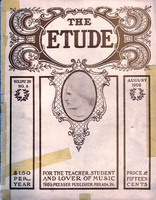The organist and choir- master should be alert at all times to find new ideas to introduce into the musical part of the service; and not only to find new ideas,—they are rare,—but especially to improve upon well-known and much-used methods. Original and uncommon capacity is oftener shown under the pressure of necessity than otherwise. The organist who has at hand well-nigh all he can wish—a fine organ, a large, well-selected library, a well-trained choir, with a fund to pay for all the special helps that he may want—is not always the man who gets the best results. I have known cases in which nearly all of the elements necessary in equipping a choir were lacking in some point, yet the work achieved was admirable. And this success was largely due to the inventive capacity and tireless energy of the leader in seeking ways to interest both choir and congregation.
A leader of this kind does not stick to beaten paths. And is that latter element not the one that keeps a choir rather low in point of efficiency? The services are usually modeled one after the other; each successive Sunday shows the same methods in use, follows the old routine. The anthems vary but little in style and usually demand the same forces.
Chorus singing, with a strong, rich organ support, is inspiring and effective; but if heard in much the same amount, power, and with about the same character, throughout an entire service and Sunday after Sunday, interest is lost. We cannot appreciate the value of music which never varies. We want contrast. There are certain musical combinations that are effective, that form what the uninitiated call “pretty chords”; but if used frequently their effect palls. Some organists are lavish with their use of diminished sevenths, dominant major ninths, and other large chord-formations, augmented fifths and sixths; so much so that everything they play—it is in their improvising that this occurs most frequently—is like an electrical display: dazzling, but not restful. After such extravagance in the use of dissonances, how quiet, how soothing it is to have a passage in the simple common chords!
So also in regard to anthems rendered with the full power of the instrumental and vocal resources. We call it brilliant, but we also want quieter work.
That is the time when the organist and choirmaster will reduce. Let him select a simple piece: such as can be sung without any instrumental support whatever. The congregation will appreciate it; there need be no fear on that score. There is a charm in unaccompanied singing that always holds an audience. This is shown by the fact that the most successful choral organizations in cities and towns are those that devote a large share of their study to madrigals, part-songs, glees, and such work as can be sung without accompaniment. The charm lies wholly in the blending of the voices and the careful shading that distinguish a well-trained choir.
The present writer suggests that a portion of the rehearsal-time be given to unaccompanied singing. Start with a hymn-tune that has variety of harmony with melodic quality, and opportunity for effects in shading. The director must be guided by the ability of his singers, both as to facility in reading and the range of their voices. He may also select tunes that will give each part some prominence. Many more tunes, frequently used, than the average singer is aware of will permit of special prominence in the inner parts. A fine example of this is Barnby’s tune “Merrial,” sung to the words, “Now the day is over,” in which the bass has prominence in the first line; in the second the alto and tenor have the greatest prominence, with the tenor strong at the end of the line, and in the third line really carrying the melody; in the fourth line the tenor and bass are most noticeable. In fact, throughout the tune the tenor is in the position of carrying the leading melody. The popular “Lead, Kindly Light,” by Dykes, offers splendid opportunities for effective unaccompanied singing. Every vocal effect that can be used in the sanctuary can find a place in the unaccompanied rendering of this tune. The setting of “Holy, Holy, Holy!” found in most hymn-books is a fine one for vocal effects. The newer hymnals of the Episcopal and Presbyterian churches are full of tunes from the best English, German, and American composers that can be used for unaccompanied work. It will be found also that congregations will appreciate a carefully rehearsed rendering of the old-time favorites. One of the most popular choirs in the city of Philadelphia often sings, just before the close of the service, while the congregation is kneeling, such hymns as “Nearer, My God, to Thee,” “Rock of Ages,” or “Just As I Am” with all the finish that a quartet of highly trained singers can give.
Aside from hymns, the organist will find it desirable to select a few pieces that can be given without accompaniment, something between a hymn-tune and a regular anthem. Some of the so-called hymn-anthems can be so used: if not as a whole, at least in part. We ask for more unaccompanied singing, in which the charm of the human voice, with the addition of skilled training, may have sway.—W. J. Baltzell.



